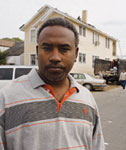 |
| Playing the Blues. Louisiana politicians (seated) feel shortchanged by White House. |
Most of New Orleans remains a ghastly ruin six months after the greatest disaster to hit a U.S. city. And if you are an elected official in Louisiana, the Bush administrations rejection of the states preferred plans for rebuilding areas flooded by Hurricane Katrina, including creation by the federal government of the Louisiana Recovery Corp. to buy and redevelop broad areas of the city, is a stinging disappointment. The White House is telling Louisiana that it must make do with $6.2 billion in Community Development Block Grants and the workings of the free market before further funds will be provided. To some Louisianians and experts in housing and development, the healing capability of the free marketsincluding the initiative of contractors both from and recently arrived in New Orleansprovide some of the most promising signs in a sea of destruction.
 |
| Contractor Labotrie: I need cash flow. |
One example is Derick Labotrie, who in late March was busy supervising a crew of Hispanic workers he had recruited only one day earlier as they renovated a house in Orleans Parish that had been flooded. Labotrie says he owns nine rental units in another part of the the city, all of them destroyed. Now he has to get money to meet the mortgage payments on those properties. I need cash flow, he says, and so he turned to home repair.
Thats the kind of entrepreneur whos going to save New Orleans more than a big developer, says Peter Werwath, vice president for program services of Columbia, Md.-based Enterprise Community Partners, who specialize in development services. He adds that block grants, free markets and development agencies and corporations all can help and that everybodys right in taking different approaches.
|
Contractors from other states say they also are helping rebuild the city. Garvin Nathaniel, general manager of Alyah Construction LLC, in October shifted the based of his company from North Carolina, where he says his work was slowing, to New Orleans. That was when he says he was called into a project to help salvage an old Catholic church and parochial school. Now, Nathaniel has switched to fixing houses and small apartment buildings, finding jobs partly by handing out flyers.
|
We are fair and honest, not the fastest guys in town, says Nathaniel, whose workers are U.S. citizens. We dont think there are enough contractors in town.
Louisiana still has a lot more to do to set the stage for broader recovery. State lawmakers in Baton Rouge continue to negotiate a plan to consolidate levee boards, which was a requirement of federal legislation financing study of Category 5 hurricane flood controls. And local civic leaders, through an organization called Citizens for
1 Greater New Orleans, support consolidation because one board with genuine expertise will allow the city to hold the Corps of Engineers accountable and provide credibility with Washington and taxpayers around the county.
Hammering out the deal isnt easy, even after the disaster, because some of the parishes fear losing control over local decisions and allocation of resources. St. Bernard Parish might be afraid it will get lost in the shuffle once the board is created and that might not be something they are willing to compromise on, says one expert on regional politics.
Nevertheless, the consensus is that levee board consolidation will soon be adopted. And once Federal Emergency Management Agency flood maps are reviewed, aid packages finalized and levee plans more precise, plenty of people who are waiting will decide to return home, some suggest. There is an incredible will to resettle, says Rebekah Green, a post-doctoral fellow at Columbia Universitys Earth Institute who is surveying residents needs.
Much less certain is how competing ideas of how to fix New Orleans will play out. Louisianians drafted legislation introduced by Sen. Richard Baker (R- La.) to create a federal agency to buy and redevelop hurricane-damaged land. Donald E. Powell, the Bush administrations coordinator for Gulf Coast rebuilding, has written that the LRC is not a long-term plan with detailed recovery needs and that the heavy hand of government should not impede the private sectors proven ability to speed the recovery....It will take longer and cost more.
Some Louisianians say its time to stop complaining and stop fighting the White House. The administration made it clear that the $6.2 billion in Community Development Block Grants is pretty much what were going to get, and according to Mr. Powell, spend that and get more, says Doug Cheramie, a Baton Rouge-based political consultant. So thats the reality of the situation. Lets spend that wisely and then get more.
Louisiana officials have made it a point to lay blame for the flooding directly at the feet of the federal government and the U.S. Army Corps. of Engineers, which is still investigating the levee failures. The Corps of Engineers failed the American people, says Sen. Mary L. Landrieu (D). There is a lot to be angry about from general bad luck to the federal government turning a cold shoulder, says John R. Beckman, a planner who works with local civic leaders.
 |
| Abandoned. Neighborhoods remain empty except for debris cleanup crews. |
According to the most recent federal estimates, Louisiana has 225,000 housing units that sustained major and severe flood damage and about two-thirds of those are in New Orleans. One encouraging sign is that in both Louisiana and Mississippi more than half of the housing units are covered by flood insurance, a higher percentage than at first believed, according to unreleased federal estimates.
Other positive signs, such as the reopening of the University of Tulane Hospital and the scheduled Mardi Gras carnival, show the potential for New Or-
leans rebounding. But in April New Orleans will try to run a mayoral election, contributing to the uncertainty surrounding recovery plans. Directing comments to the 300,000 people who lost homes and had to leave, the number one priority of state government, said Gov. Kathleen Blanco in a Feb. 6 speech, is to bring you home.
(Photo top by AP/Wideworld; middle and bottom by Michael Goodman for ENR)


Post a comment to this article
Report Abusive Comment